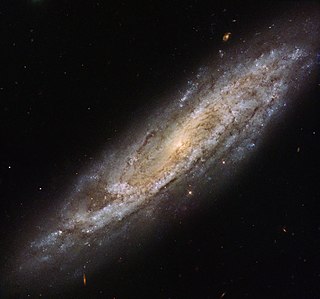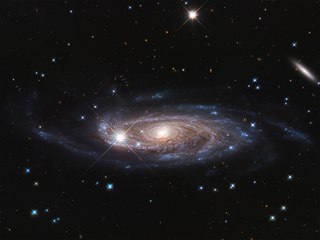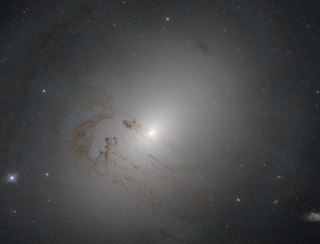
Messier 100 is a grand design intermediate spiral galaxy in the southern part of the mildly northern Coma Berenices. It is one of the brightest and largest galaxies in the Virgo Cluster and is approximately 55 million light-years from our galaxy, its diameter being 107,000 light years, and being about 60% as large. It was discovered by Pierre Méchain in 1781 and 29 days later seen again and entered by Charles Messier in his catalogue "of nebulae and star clusters". It was one of the first spiral galaxies to be discovered, and was listed as one of fourteen spiral nebulae by Lord William Parsons of Rosse in 1850. NGC 4323 and NGC 4328 are satellite galaxies of M100; the former is connected with it by a bridge of luminous matter.

The Pinwheel Galaxy is a face-on, unbarred, and counterclockwise spiral galaxy located 21 million light-years from Earth in the constellation Ursa Major. It was discovered by Pierre Méchain in 1781 and was communicated that year to Charles Messier, who verified its position for inclusion in the Messier Catalogue as one of its final entries.

A starburst galaxy is one undergoing an exceptionally high rate of star formation, as compared to the long-term average rate of star formation in the galaxy, or the star formation rate observed in most other galaxies.

Messier 99 or M99, also known as NGC 4254 or St. Catherine's Wheel, is a grand design spiral galaxy in the northern constellation Coma Berenices approximately 15,000,000 parsecs from the Milky Way. It was discovered by Pierre Méchain on 17 March 1781. The discovery was then reported to Charles Messier, who included the object in the Messier Catalogue of comet-like objects. It was one of the first galaxies in which a spiral pattern was seen. This pattern was first identified by Lord Rosse in the spring of 1846.

NGC 5195 is a dwarf galaxy that is interacting with the Whirlpool Galaxy. Both galaxies are located approximately 25 million light-years away in the constellation Canes Venatici. Together, the two galaxies are one of the most famous interacting galaxy pairs.

NGC 6946, sometimes referred to as the Fireworks Galaxy, is a face-on intermediate spiral galaxy with a small bright nucleus, whose location in the sky straddles the boundary between the northern constellations of Cepheus and Cygnus. Its distance from Earth is about 25.2 million light-years or 7.72 megaparsecs, similar to the distance of M101 in the constellation Ursa Major. Both were once considered to be part of the Local Group, but are now known to be among the dozen bright spiral galaxies near the Milky Way but beyond the confines of the Local Group. NGC 6946 lies within the Virgo Supercluster.

The Antennae Galaxies are a pair of interacting galaxies in the constellation Corvus. They are currently going through a starburst phase, in which the collision of clouds of gas and dust, with entangled magnetic fields, causes rapid star formation. They were discovered by William Herschel in 1785.
VIRGOHI21 is an extended region of neutral hydrogen (HI) in the Virgo cluster discovered in 2005. Analysis of its internal motion indicates that it may contain a large amount of dark matter, as much as a small galaxy. Since VIRGOHI21 apparently contains no stars, this would make it one of the first detected dark galaxies. Skeptics of this interpretation argue that VIRGOHI21 is simply a tidal tail of the nearby galaxy NGC 4254.

Interacting galaxies are galaxies whose gravitational fields result in a disturbance of one another. An example of a minor interaction is a satellite galaxy disturbing the primary galaxy's spiral arms. An example of a major interaction is a galactic collision, which may lead to a galaxy merger.

NGC 4013 is an edge-on barred spiral galaxy about 55 million light-years away in the constellation Ursa Major. The disk of NGC 4013 shows a distinct "peanut"-shaped bulge in long exposure photographs that N-body computer simulations suggest is consistent with a stellar bar seen perpendicular to the line of sight.

NGC 2207 and IC 2163 are a pair of colliding spiral galaxies about 80 million light-years away in the constellation Canis Major. Both galaxies were discovered by John Herschel in 1835.

NGC 3432 is an edge-on spiral galaxy that can be found in the northern constellation of Leo Minor. It was discovered by German-British astronomer William Herschel on March 19, 1787. This galaxy is located at a distance of 40 million light-years (12.3 Mpc) from the Milky Way. It is interacting with UGC 5983, a nearby dwarf galaxy, and features tidal filaments and intense star formation. Because of these features, it was listed in Halton Arp's Atlas of Peculiar Galaxies.

NGC 2770 is a spiral galaxy in the northern constellation of Lynx, near the northern constellation border with Cancer. It was discovered by German-born astronomer William Herschel on December 7, 1785. J. L. E. Dreyer described it as, "faint, large, much extended 150°, mottled but not resolved, 2 stars to north". NGC 2770 was the target for the first binocular image produced by the Large Binocular Telescope.

UGC 2885 is a large barred spiral galaxy of type SA(rs)c in the constellation Perseus. It is 232 million light-years (71 Mpc) from Earth and measures 463,000 ly (142,000 pc) across, making it one of the largest known spiral galaxies. It is also a possible member of the Pisces-Perseus supercluster.

NGC 2655 is a lenticular galaxy in the constellation Camelopardalis. It is at a distance of 60 million light years from Earth. NGC 2655 is a Seyfert galaxy. The galaxy has asymmetric dust lanes in the centre of the galaxy, tidal arms and extended neutral hydrogen gas and may have recently experienced a merger. The complex dynamics of the HI and optical tails suggest the galaxy may have undergone more mergers in the past. A weak bar has been detected in infrared H band. The diameter of the disk of the galaxy is estimated to be 60 Kpc.

NGC 2623(also known as ARP 243) is an interacting galaxy located around 263 million light-years away in the constellation Cancer. Due to NGC 2623 being in the late stage of merging, the compression of the gas within the galaxy has led to a large amount of star formation, and to its unique structure of a bright core with two extending tidal tails.NGC 2623 was discovered on January 19, 1885, by Édouard Jean-Marie Stephan. NGC 2623 does not have an active galactic nucleus, and only one supernova was observed in NGC 2623, SN 1999gd, a Type 1a Supernova that was discovered in 1999.

NGC 3256 is a peculiar galaxy formed from the collision of two separate galaxies in the constellation of Vela. NGC 3256 is located about 100 million light-years away and belongs to the Hydra–Centaurus Supercluster complex. NGC 3256 provides a nearby template for studying the properties of young star clusters in tidal tails. The system hides a double nucleus and a tangle of dust lanes in the central region. The telltale signs of the collision are two extended luminous tails swirling out from the galaxy. The tails are studded with a particularly high density of star clusters. NGC 3256 is the most luminous galaxy in the infrared spectrum located within z 0.01 from Earth.

NGC 2865 is an isolated elliptical galaxy in the equatorial constellation of Hydra. The core region of the galaxy shows a kinematically distinct component showing indications of a recent accretion or merger event that led to a burst of star formation around the nucleus. Observational constraints require this to have occurred within the last 100–400 million years, with the merger most likely being an Sb or Sc-class spiral galaxy.

NGC 536 is a barred spiral galaxy located in the constellation Andromeda. It is located at a distance of circa 200 million light-years from Earth, which, given its apparent dimensions, means that NGC 536 is about 180,000 light years across. It was discovered by William Herschel on September 13, 1784. It is a member of Hickson Compact Group 10, which also includes the galaxies NGC 529, NGC 531, and NGC 542. It belongs to the Perseus–Pisces Supercluster.

NGC 3656 is a peculiar galaxy formed by the collision of two galaxies in the constellation of Ursa Major. It is located about 135 million light years away from Earth, which means, given its apparent dimensions, that NGC 3656 is approximately 70,000 light years across. It was discovered by William Herschel on April 14, 1789.




















